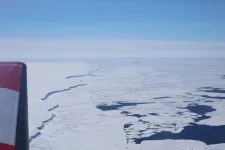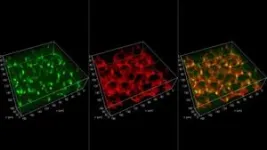(Press-News.org) A new Antarctic ice sheet modeling study from scientists at UC San Diego’s Scripps Institution of Oceanography suggests that meltwater flowing out to sea from beneath Antarctic glaciers is making them lose ice faster.
The model’s simulations suggest this effect is large enough to make a meaningful contribution to global sea-level rise under high greenhouse gas emissions scenarios.
The extra ice loss caused by this meltwater flowing out to sea from beneath Antarctic glaciers is not currently accounted for in the models generating major sea-level rise projections, such as those of the Intergovernmental Panel on Climate Change (IPCC). If this process turns out to be an important driver of ice loss across the entire Antarctic ice sheet, it could mean current projections underestimate the pace of global sea-level rise in decades to come.
“Knowing when and how much global sea-level will rise is critical to the welfare of coastal communities,” said Tyler Pelle, the study’s lead author and a postdoctoral researcher at Scripps. “Millions of people live in low-lying coastal zones and we can’t adequately prepare our communities without accurate sea-level rise projections.”
The study, published October 27 in Science Advances and funded by the National Science Foundation (NSF), NASA, and the Cecil H. and the Ida M. Green Foundation for Earth Sciences at the Institute of Geophysics and Planetary Physics at Scripps, modeled the retreat of two glaciers in East Antarctica through the year 2300 under different emissions scenarios and projected their contributions to sea-level rise. Unlike previous Antarctic ice sheet models, this one included the influence of this flow of meltwater from beneath glaciers out to sea, which is known as subglacial discharge.
The two glaciers the study focused on, named Denman and Scott, together hold enough ice to cause nearly 1.5 meters (5 feet) of sea-level rise. In a high emissions scenario (IPCC’s SSP5-8.5 scenario, which assumes no new climate policy and features 20% higher CO2 emissions by 2100), the model found that subglacial discharge increased the sea-level rise contribution of these glaciers by 15.7%, from 19 millimeters (0.74 inches) to 22 millimeters (0.86 inches) by the year 2300.
These glaciers, which are right next to each other, sit atop a continental trench that is more than two miles deep; once their retreat reaches the trench’s steep slope, their contribution to sea-level rise is expected to accelerate dramatically. With the added influence of subglacial discharge, the model found that the glaciers retreated past this threshold about 25 years earlier than they did without it.
“I think this paper is a wake up call for the modeling community. It shows you can’t accurately model these systems without taking this process into account,” said Jamin Greenbaum, co-author of the study and a researcher at Scripps’ Institute of Geophysics and Planetary Physics.
A key takeaway, beyond the understudied role of subglacial discharge in accelerating sea-level rise, is the importance of what humanity does in the coming decades to rein in greenhouse gas emissions, said Greenbaum. The low emissions scenario runs of the model did not show the glaciers retreating all the way into the trench and avoided the resulting runaway contributions to sea-level rise.
“If there is a doomsday story here it isn’t subglacial discharge,” said Greenbaum. “The real doomsday story is still emissions and humanity is still the one with its finger on the button.”
In Antarctica, subglacial meltwater is generated from melting that occurs where the ice sits on continental bedrock. The main sources of the heat melting the ice in contact with the ground are friction from the ice grinding across the bedrock and geothermal heat from Earth’s interior permeating up through the crust.
Prior research suggested that subglacial meltwater is a common feature of glaciers around the world and that it is present under several other massive Antarctic glaciers, including the infamous Thwaites Glacier in West Antarctica.
When subglacial discharge flows out to sea it is thought to accelerate melting of the glacier’s ice shelf – a long floating tongue of ice that extends out to sea beyond the last part of the glacier that is still in contact with solid ground (known as the grounding line). Subglacial discharge is thought to speed up ice shelf melting and glacial retreat by causing ocean mixing that stirs in additional ocean heat within the cavity beneath a glacier's floating ice shelf. This enhanced ice shelf melting then causes the upstream glacier to accelerate, which can drive sea level rise.
The notion that subglacial discharge causes additional ice shelf melting is widely accepted in the scientific community, said Greenbaum. But it hasn’t been included in sea-level rise projections because many researchers weren’t sure if the process’ effect was sufficiently large to increase sea-level rise, mainly because its effects are localized around the glacier’s ice shelf.
Pelle said subglacial discharge came onto his radar in 2021 when he and his colleagues observed that East Antarctica’s Denman Glacier’s ice shelf was melting faster than expected given local ocean temperatures. Puzzlingly, Denman’s neighbor Scott Glacier’s ice shelf was melting much more slowly despite virtually identical ocean conditions.
To test whether subglacial discharge could reconcile the melt rates seen at the Denman and Scott ice shelves, as well as whether subglacial meltwater might accelerate sea-level rise, the team combined models for three different environments: the ice sheet, the space between the ice sheet and bedrock, and the ocean.
Once the researchers married the three models into one they ran a series of projections up to 2300 using a NASA supercomputer.
The projections featured three main scenarios: a control that featured no additional ocean warming, a low emissions pathway (SSP1-2.6), and a high emissions pathway (SSP5-8.5). For each scenario, the researchers created projections with and without the effect of present-day levels of subglacial discharge.
The model’s simulations revealed that adding in subglacial discharge reconciled the melt rates seen at Denman and Scott Glaciers. As for why Scott Glacier was melting so much slower than Denman, Pelle said the model showed that “a strong subglacial discharge channel drained across the Denman Glacier grounding line, while a weaker discharge channel drained across the Scott Glacier grounding line.” The strength of the discharge channel at Denman, Pelle explained, was behind its speedy melt.
For the control and low-emissions model runs the contributions to sea-level rise were close to zero or even slightly negative with or without subglacial discharge at 2300. But in a high emissions scenario, the model found that subglacial discharge increased the sea-level rise contribution of these glaciers from 19 millimeters (0.74 inches) to 22 millimeters (0.86 inches) in 2300.
In the high emissions scenario that included subglacial discharge, Denman and Scott Glaciers retreated into the two-mile-deep trench beneath them by 2240, about 25 years earlier than they did in the model runs without subglacial discharge. Once the grounding lines of the Denman and Scott Glaciers retreat past the lip of this trench their yearly sea-level rise contribution explodes, reaching a peak of 0.33 millimeters (0.01 inches) per year – roughly half of the present-day annual sea-level rise contribution of the entire Antarctic ice sheet.
Pelle said the trench’s steep slope is behind this explosive increase in sea-level rise contribution. As the glacier retreats down slope, its ice shelf begins losing thicker and thicker slabs of ice from its leading edge. This process of ice loss quickly outpaces ice accumulation at the ice sheet’s interior, causing further glacial retreat. Researchers refer to this process as "Marine Ice Sheet Instability," and it can promote explosive ice loss from glaciers like Denman and Scott.
Researchers refer to topography such as the trench beneath Denman and Scott Glaciers as a retrograde slope and worry that it creates a positive feedback loop by which glacial retreat begets more retreat. Large areas of the West Antarctic Ice Sheet, such as Thwaites Glacier, also have retrograde slopes that, while not as dramatic as the Denman-Scott trench, contribute to fears of broader ice sheet instability.
“Subglacial meltwater has been inferred beneath most if not all Antarctic glaciers, including Thwaites, Pine Island, and Totten glaciers,” said Pelle. “All these glaciers are retreating and contributing to sea-level rise and we are showing that subglacial discharge could be accelerating their retreat. It’s urgent that we model these other glaciers so we can get a handle on the magnitude of the effect subglacial discharge is having.”
The researchers behind this study are doing just that. Pelle said they are in the process of submitting a research proposal to extend their new model to the entire Antarctic ice sheet.
Future iterations of the model may also attempt to couple the subglacial environment with the ice sheet and ocean models so that the amount of subglacial meltwater dynamically responds to these other factors. Greenbaum said that the current version of their model kept the amount of subglacial meltwater constant throughout the model runs, and that making it respond dynamically to the surrounding environment would likely make the model more true to life.
“This also means that our results are probably a conservative estimate of the effect of subglacial discharge,” said Greenbaum. “That said, we can’t yet say how much sea-level rise will be accelerated by this process – hopefully it’s not too much.”
Part of Greenbaum’s upcoming fieldwork in Antarctica, supported by NSF and NASA, aims to directly investigate the impacts of subglacial meltwater in both the East and West Antarctic ice sheets. In collaboration with the Australian Antarctic Division and the Korea Polar Research Institute, Greenbaum and his collaborators will be visiting the ice shelves of Denman and Thwaites Glaciers in East and West Antarctica, respectively, looking for direct evidence that subglacial freshwater is discharging into the ocean beneath the glaciers’ ice shelves and contributing to warming.
In addition to Pelle and Greenbaum, the study was co-authored by Christine Dow of the University of Waterloo, Adrian Jenkins of Northumbria University, and Mathieu Morlighem of Dartmouth College.
END
Meltwater flowing beneath Antarctic glaciers may be accelerating their retreat
Simulations showed that this process accelerated sea-level rise by 15% by 2300, suggesting it should be factored into future projections
2023-10-27
ELSE PRESS RELEASES FROM THIS DATE:
Underwater robot finds new circulation pattern in Antarctic ice shelf
2023-10-27
ITHACA, N.Y. – More than merely cracks in the ice, crevasses play an important role in circulating seawater beneath Antarctic ice shelves, potentially influencing their stability, finds Cornell University-led research based on a first-of-its-kind exploration by an underwater robot.
The remotely operated Icefin robot’s climb up and down a crevasse in the base of the Ross Ice Shelf produced the first 3D measurements of ocean conditions near where it meets the coastline, a critical juncture known as the grounding zone.
The robotic survey revealed a new circulation pattern – a jet funneling water sideways through the crevasse – in addition to rising and sinking currents, ...
Like humans, baboons are strategic cooperators
2023-10-27
A team led by CNRS scientists1 has discovered that, just like humans, Guinea baboons develop complex strategies to select partners for cooperation, basing their decisions on past interactions. Humans naturally engage in strategic cooperation in many contexts. For example, when children help schoolmates by lending them their class notes, they may expect the same in return the next time: this is known as reciprocity. But if the favour is not returned, they are likely to seek others with whom to cooperate.
The team’s findings ...
Hidden way for us to feel touch uncovered by Imperial researchers
2023-10-27
Imperial researchers have discovered a hidden mechanism within hair follicles that allow us to feel touch.
Previously, touch was thought to be detected only by nerve endings present within the skin and surrounding hair follicles. This new research from Imperial College London has found that that cells within hair follicles – the structures that surround the hair fibre – are also able to detect the sensation in cell cultures.
The researchers also found that these hair follicle cells release the neurotransmitters histamine and serotonin in response to touch – findings that ...
Study: Metformin can help youth manage weight gain side effect of bipolar medications
2023-10-27
A new large-scale study led by researchers at the University of Cincinnati and Northwell Health, New York's largest health care provider, found the drug metformin can help prevent or reduce weight gain in youth taking medication to treat bipolar disorder.
The collaborative team presented its findings during a symposium at the American Academy of Child and Adolescent Psychiatry conference in New York City Oct. 27.
Weight gain side effect
Medications to treat bipolar disorder, known as second-generation antipsychotics (SGAs), are often effective at helping young ...
AI can alert urban planners and policymakers to cities’ decay
2023-10-27
By April Toler
More than two-thirds of the world’s population is expected to live in cities by 2050, according to the United Nations. As urbanization advances around the globe, researchers at the University of Notre Dame and Stanford University said the quality of the urban physical environment will become increasingly critical to human well-being and to sustainable development initiatives.
However, measuring and tracking the quality of an urban environment, its evolution and its spatial disparities is difficult due to the amount of on-the-ground data needed to capture these patterns. To address the issue, Yong Suk Lee, assistant professor of technology, ...
NASA rocket to see sizzling edge of star-forming supernova
2023-10-27
A new sounding rocket mission is headed to space to understand how explosive stellar deaths lay the groundwork for new star systems. The Integral Field Ultraviolet Spectroscopic Experiment, or INFUSE, sounding rocket mission, will launch from the White Sands Missile Range in New Mexico on Oct. 29, 2023, at 9:35 p.m. MDT.
For a few months each year, the constellation Cygnus (Latin for “swan”) swoops through the northern hemisphere’s night sky. Just above its wing is a favorite target ...
IU scientists part of NIH-funded national consortium focused on improving Alzheimer’s disease diagnoses
2023-10-27
INDIANAPOLIS—Researchers at Indiana University School of Medicine will play key roles in a national consortium led by Wake Forest University School of Medicine to study the use, interpretation and implementation of biomarkers to diagnose Alzheimer’s disease.
The multi-institution effort is funded by a five-year, $9 million grant from the National Institute on Aging, part of the National Institutes of Health, that will establish the Alzheimer’s Diagnosis in Older Adults with Chronic Conditions (ADACC) Network.
IU School of Medicine’s Nicole Fowler, ...
Tri-City to partner with UC San Diego Health in delivering world-class medical care
2023-10-27
After open public discussion and a unanimous board vote, Tri-City Healthcare District (“Tri-City” or “District”) announced yesterday that UC San Diego Health has been selected as the District’s future health care partner. A Joint Powers Agreement will now be co-developed that allows UC San Diego Health to provide administrative, clinical and operational management for all health care services with direct input and guidance from a diverse community board. Under the future agreement, UC San Diego ...
Physicist Tatiana Erukhimova earns national award for science outreach
2023-10-27
Texas A&M University physicist Dr. Tatiana Erukhimova has been selected as the 2023 recipient of the American Physical Society Dwight Nicholson Medal for Outreach. Established in 1994 by the Division of Plasma Physics and the Forum on Physics and Society, the Nicholson Medal is awarded annually in recognition of the humanitarian aspect of physics and physicists created through public lectures and public media, teaching, research or science-related activities. The medal is sponsored by the friends of the late plasma physicist and award namesake Dr. Dwight R. Nicholson (1947-1991), former chairman ...
Burt’s Bees® presents clinical evidence demonstrating ability of nature-based products to support barrier function and microbiome health in sensitive skin and lips
2023-10-27
DURHAM, N.C., Oct. 27, 2023 – Burt’s Bees, the #1 dermatologist recommended natural skin care brand* and a pioneer in skin care solutions, announced its latest research findings on the benefits of nature-based regimens to cleanse, nourish, and protect skin health. The studies will be presented at the hybrid Integrative Dermatology Symposium (IDS) from Oct. 27-29, 2023.
The latest research findings from Burt’s Bees highlight:
The ability of a topical treatment with a unique blend of botanicals to improve appearance of age spots in diverse skin.
The impact of a lip care product with naturally derived plant oils, butters, beeswax, ...
LAST 30 PRESS RELEASES:
New study shows how the spleen helps the immune system accept a transplant
New Mayo Clinic study advances personalized prostate cancer education with an EHR-integrated AI agent
Researchers identify novel therapeutic target to improve recovery after nerve injury
Microbes in breast milk help populate infant gut microbiomes
Reprogramming immunity to rewrite the story of Type 1 diabetes
New tool narrows the search for ideal material structures
Artificial saliva containing sugarcane protein helps protect the teeth of patients with head and neck cancer
Understanding the role of linear ubiquitination in T-tubule biogenesis
Researchers identify urban atmosphere as primary reservoir of microplastics
World’s oldest arrow poison – 60,000-year-old traces reveal early advanced hunting techniques
Bristol scientists discover early sponges were soft
New study uncovers how rice viruses manipulate plant defenses to protect insect vectors
NSF–DOE Vera C. Rubin Observatory spots record-breaking asteroid in pre-survey observations
Ribosomal engineering creates “super-probiotic” bacteria
This self-powered eye tracker harnesses energy from blinking and is as comfortable as everyday glasses
Adverse prenatal exposures linked to higher rates of mental health issues, brain changes in adolescents
Restoring mitochondria shows promise for treating chronic nerve pain
Nature study identifies a molecular switch that controls transitions between single-celled and multicellular forms
USU chemists' CRISPR discovery could lead to single diagnostic test for COVID, flu, RSV
Early hominins from Morocco reveal an African lineage near the root of Homo sapiens
Small chimps, big risks: What chimps show us about our own behavior
We finally know how the most common types of planets are created
Thirty-year risk of cardiovascular disease among healthy women according to clinical thresholds of lipoprotein(a)
Yoga for opioid withdrawal and autonomic regulation
Gene therapy ‘switch’ may offer non-addictive pain relief
Study shows your genes determine how fast your DNA mutates with age
Common brain parasite can infect your immune cells. Here's why that's probably OK
International experts connect infections and aging through cellular senescence
An AI–DFT integrated framework accelerates materials discovery and design
Twist to reshape, shift to transform: Bilayer structure enables multifunctional imaging
[Press-News.org] Meltwater flowing beneath Antarctic glaciers may be accelerating their retreatSimulations showed that this process accelerated sea-level rise by 15% by 2300, suggesting it should be factored into future projections





